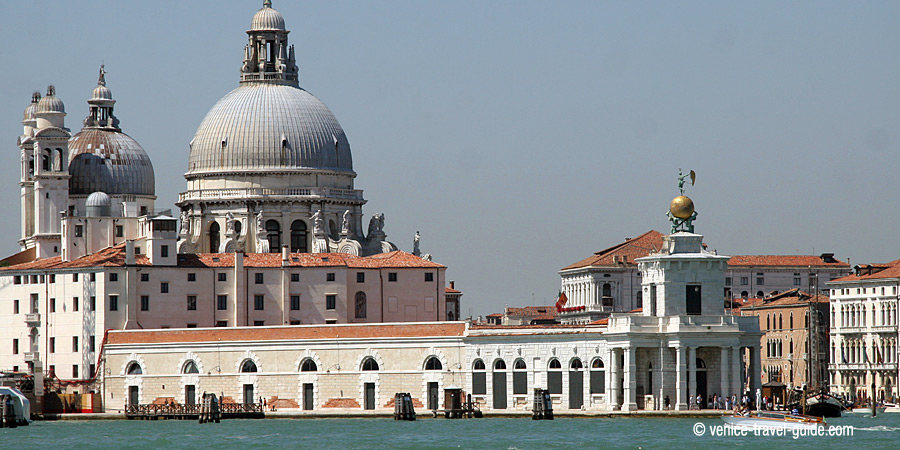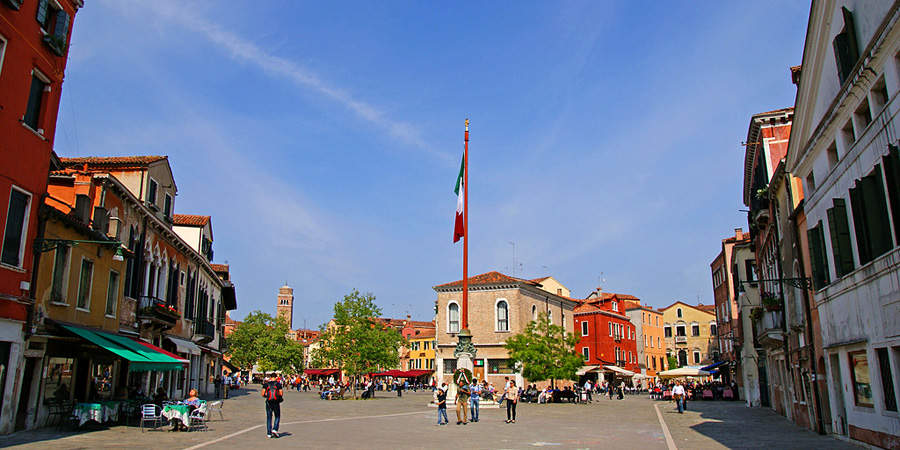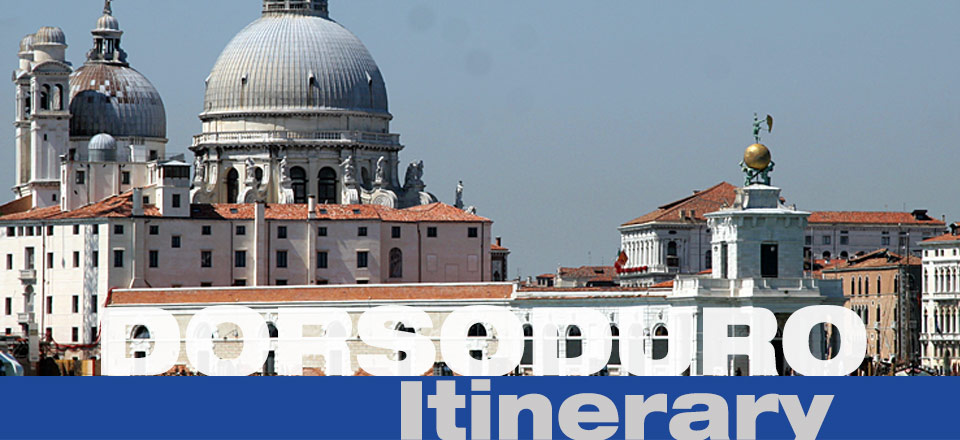Dorsoduro, one of the six sestieri of Venice, includes the highest land areas of the city and also Giudecca island and Sacca Fisola island. Its name derives from the Italian for "hard ridge", due to its comparatively high, stable land. The original heart of the area was the Giudecca Canal, along which building were constructed.
By the eleventh century, settlement had spread across to the Canal Grande, while later religious buildings including the Basilica di Santa Maria della Salute and the Zattere quay are now its main landmarks. In the nineteenth century the Accademia was set up in Dorsoduro and the Ponte dell'Accademia linked it to San Marco, making it an expensive area popular with foreign residents. The western quarter, end and the Giudecca, became industrialised around this time.
Attractions on the main islands include the Peggy Guggenheim Collection, the Palazzo Dario, San Trovaso, San Pantalon, San Nicolò da Tolentino, the Ospedale Giustinian, the Church of San Sebastiano, the Palazzo Ariani, the Palazzo Zenobio, the Church of Santa Maria del Carmelo and Scuola Grande dei Carmini, Campo Santa Margherita, Ca' Foscari, Ca' Rezzonico and Campo San Barnaba.
Punta della Dogana François Pinault Found.

With its triangular shape, Punta della Dogana split the Grand Canal from the Giudecca Canal. As center for contemporary art, the former monumental port of the city present a permanent exhibition of works from François Pinault Collection.
The seventeenth-century building, work of Benoni, consisting of 8 sections developed on two floors and crowned by a tower topped by the Palla d'Oro, gilded globe supported by two atlases, to depict the world on which rests the statue called Occasio. This statue represents Fortune, by the sculptor Bernardo Falconi, rotating to show the direction of the wind and, symbolically, the fickleness of fortune.
Church of the Gesuati

The order of the Jesuits was suppressed in 1868 and the church and monastery were handed over to the Dominicans. In 1724 the architect Giorgio Massari was commissioned to build the new church, the Chiesa dei Gesuati. The inside has no side naves but particularly interesting is the ceiling decorated by Giambattista Tiepolo.
Giambattista Tiepolo was commissioned with decorating the ceiling with illustrations of the history of the Dominicans. These, together with the other works of art housed in the church, make this one of the most interesting and complete examples of Venetian XVIII century art: other important artists such as Giambattista Piazzetta, Sebastiano Ricci and Gian Maria Morlaiter also worked there. Of great importance is also an altarpiece by Jacopo Tintoretto, restored by Giambattista Piazzetta, depicting the Crucifixion, which comes from the old church.
Church of San Trovaso

The current building of the Chiesa di San Trovaso (Venetian contraction to indicate the Saints Gervasio and Protasio) dates back to the end of the sixteenth century and is in Palladian style. It contains works by Tintoretto, Palma il Giovane and Gianbono. A singular feature of the building is double-facade.
One facing the Campo San Trovaso and the other facing the river of the same name. According to tradition, the dual entrance was needed to keep apart rival factions of Castellani and Nicolotti, when both attended church at the commemoration of the saints, in order to prevent the outbreak of fighting.
Squero di San Trovaso

The Squero di San Trovaso is located next to the church of San Trovaso. This is an unusual wooden structure that is similar to the house of the Cadore area on the mainland. This was an old dwelling for the workers of the squero, a small shipyards for making gondolas. It dates back to the seventeenth century and has always been in operation.
The fact that the workers often came from Cadore is the reason why the house is in the style of this mountanious area. It is one of the few dry docks still in operation in Venice, although today there are produced or repaired only gondolas, while in the past the shipbuilding activity also extended to other types of boats.
Church of San Sebastiano

The Chiesa di San Sebastiano was designed by Scarpagnino in the sixteenth century. In 1555 Paolo Veronese began to create the many paintings that adorn the sacristy, the ceiling of the central nave and the apse of the main altar. At the foot of the organ, which is also decorated with works by Veronese.
A stone indicates the place were the artist is buried. The confraternity of Gerolimine fathers founded the church in the 15th century, and then in 1506 a series of alterations gave the building its present appearance: a single-nave interior preceded by an atrium and raised choir and culminating in an apsidal presbytery under a cupola.
Church of Angelo Raffaele

The Chiesa dell'Angelo Raffaele stands in one of the oldest areas of the city, among the first to be colonized. According to tradition, is one of the eight churches that San Magno, Bishop of Oderzo erected in the early days of the city. The foundation of the church dates back to the seventh century shortly after Venice was first settled.
But the church was rebuilt in 1618. Inside, the organ nave contains a wash drawing by Giannantonio Guardi dated 1750 that depicts stories about Tobiolo. Parts of this church and that of San Nicolò dei Mendicoli are the oldest in Venice.
Church of San Nicolò dei Mendicoli

The Chiesa di San Nicolò dei Mendicoli is one of Venice's oldest churches, it was founded by patavini (inhabitants of Padua), who lived in the islands of the lagoon in the seventh century to escape the Lombard invasion. It was rebuilt in the twelfth century, and the central part of the facade dates back to that period.
The arch in the apse of the main altar is Byzantine. The church was seriously damaged by the flood of November 4, 1966, and in the seventies was the center of a complex restoration.
Zenobio Palace

The Palazzo Zenobio was originally in Gothic style and belonged to the Morosini family. In the seventeenth century it was sold to the Zenobio family, who commissioned the architect Antonio Gaspari to completely renovate it. Inside, it is decorated with stuccoes by the Swiss plasterer Abbondio Stazio and with frescoes by Luigi Dorigny.
The ballroom still contains the stand for the orchestra above the central door. Paintings by Carlevaris adorn the small portico. The fine classical portico overlooks the vast French style garden.
Scuola Grande dei Carmini

The headquarters of the Carmelite lay confraternity that provided assistance and charity. It was also dedicated to the cult of the Virgin Mary and was officially estabilished in 1595. The Scuola Grande dei Carmini was built by Longhena in 1667 on pre-existing smaller buildings.
In 1739 Tiepolo painted pictures for the ceiling of the albergo (great hall) with symbols of the Virgin Mary and Saint Simeon Stock receiving the scapular of the Carmelite Order from the Virgin. It was the last school to be recognized "Grande", in 1767.
Santa Margherita Square

Campo Santa Margherita is a picturesque square surrounded by old fourteenth century palaces and the little church, Santa Margherita, which is today a university auditorium. The old belltower still has Baroque stone decorations.
The current appearance is due to the interventions of the second half of the nineteenth century decreed by the Austro-Hungarian authorities that, for reasons of hygiene, buried some rivers. The Santa Margherita Square is known because it is the traditional venue for youth people, given the proximity of the IUAV, Ca' Foscari University and various colleges.
Ca' Rezzonico

One of the most beautiful Palaces in Venice, Ca' Rezzonico was started by Longhena for the Bartolomeo Bon family in 1667. It was completed for the Rezzonico family (who had become joint owners) by Giorgio Massari, who made considerable modifications, such as the large staircase and the ballroom, which was decorated with frescoes by Crosato.
Today, it is a museum dedicated to eighteenth century Venice and contains period pieces taken from other palazzi, the most famous of which is the carved furniture by Andrea Brustolon.
San Barnaba and Ponte dei Pugni bridge

Campo San Barnaba is a typical Venetian campo at which the boats selling vegetables coming from the islands moored. It is located along the main route that connects the area of the Ponte dell'Accademia to Piazzale Roma. It is dominated by the church of San Barnaba, what, with his imposing neoclassical facade.
This neoclassical facade occupies the entire south side of the campo. Nearby, there is the Ponte dei Pugni. It takes its name from a spectacular dispute between two opposing Venetian factions, the Castellanis and the Nicolottis, who fought on the bridge and who left their footprints on it.


